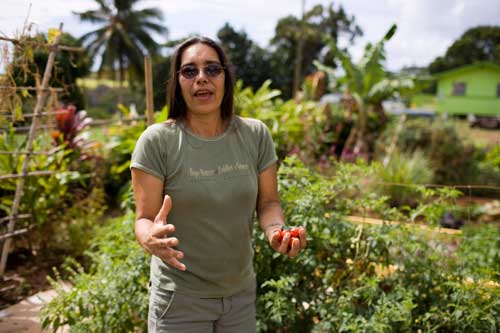State widens food stamp eligibility

Lillie Gonzales discussed growing vegetables in her home garden on Kauai to help feed her family. Gonzales and her husband do whatever it takes to provide food for the family, including taking advantage of expanded food stamp eligibility.
Lillie Gonzales does whatever it takes to provide for three ravenous sons who live under her roof. She grows her own vegetables at home on Kauai, runs her own small business and, like a record 42 million other Americans, she relies on food stamps.
Gonzales and her husband consistently qualify for food stamps now that Hawaii and other states are quietly expanding eligibility and offering the benefit to more working, moderate-income families.
Data from the U.S. Department of Agriculture reviewed by the Associated Press shows that 30 states have adopted rules making it easier to qualify for food stamps since 2007. In all, 38 states have loosened eligibility standards.
Hawaii has gone farther than most, allowing a family like Gonzales’ to earn up to $59,328 and still get food stamps.
Prior to an Oct. 1 increase, the income eligibility limit for a Hawaii family of five was $38,568 a year.
"If I didn’t have food stamps, I would be buying white rice and Spam every day," said Gonzales, whose Island Angels business makes Hawaiian-style fabric angel ornaments, quilts, aprons and purses.
Don't miss out on what's happening!
Stay in touch with breaking news, as it happens, conveniently in your email inbox. It's FREE!
Eligibility for food stamps varies from state to state, with the 11 most generous states allowing families to apply if their gross income is less than double the federal poverty line of $22,050 for a family of four on the mainland. The threshold is higher in Alaska and Hawaii.
With more than one in eight Americans now on food stamps, participation in the program has jumped about 70 percent from 26 million in May 2007, while the nation’s unemployment rate rose from 4.3 percent to 9.2 percent through September of this year.
"We’ve seen a huge increase in participation due to the economic downturn," said Jean Daniel, a spokeswoman for the USDA’s Food and Nutrition Service. "That’s the way this program was designed."
In addition to helping alleviate economic pressures, many states embrace the popularity of food stamps because their cost — $50 billion last year — is paid entirely by the federal government. States are responsible only for paying half of their programs’ administrative costs.
Food stamps have been blasted by some Republicans in this midterm election season as just another federal entitlement program, with former House Speaker Newt Gingrich framing the vote as a choice between "the party of food stamps" and Republican policies that create jobs.
Participants in the food stamp program, technically called the Supplemental Nutrition Assistance Program, receive a per-person average of $133 per month to buy staples including milk, bread and vegetables.
Shortly after Hawaii announced it was raising its eligibility limits starting this month, three carloads of 10 seniors drove to the Kauai Independent Food Bank to ask if they qualified. Nine of them did, said Judy Lenthall, executive director for the food bank, which helps people apply for food stamps.
"We saw an immediate and overwhelmingly wonderful response," Lenthall said. "It surprised us how fast it’s spreading."
The only states that have not eased food stamp eligibility requirements since 2000 are Alaska, Arkansas, Indiana, Iowa, Kansas, Missouri, Nebraska, South Dakota, Tennessee, Utah, Virginia and Wyoming.
In Hawaii, where everything from milk to gasoline typically costs the highest in the nation, the changes are welcomed by Gonzales and others.
"As long as my kids have good food, that’s all I care about," Gonzales said. "It makes a tremendous difference."



